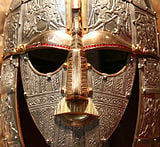Members Only 36 – Jorvik with Andrew Jones part 3


A Chronological History of Britain
Every episode of The British History Podcast. This category includes cultural history, storyline episodes, English history, Welsh history, Scottish history, and even some Irish history and Roman history thrown in.


Podcast: Play in new window | Download
Ok, so last time we talked about how Aethelberht of Kent invaded the kingdom of Wessex and was pushed out by Ceawlin and his army. We don’t have a lot of facts regarding that conflict, we aren’t even told why they were fighting, but we know that they were both destined to become Bretwaldas and that in the end Aethelberht was chased back into Kent. And, presumably following this moment, Ceawlin earned the title of Bretwalda. So good for him.
But there’s a lot that goes into war beyond one king puffing up his chest and the other king saying “Come at me, bro!” Much as I wish it were that simple and comical, real war is a great deal more complex than that.
So lets start by talking about the men who would be fighting these battles. Of course, you have the kings (one of the Old English terms for these kings, by the way, was þeoden… yeah. Like theoden in the Lord of the Rings). Another fun anglo saxon term for King is Cyning. In old english, “ing” means scion. Which is why you start hearing of the sons of nobles being referred to as Aethlings… they’re the scions of nobles. But in this case, Cyning is the scion of the Cynn… which translates to the Kindred, or the family. This can be taken as either the ruling family, which would call back to that families tradition of rule, or it could be taken as the larger form of kindred… as the Cyning is the son of the people.

Podcast: Play in new window | Download
So the year is 586, and Ceawlin is the leader of the men of Wessex. Wessex has been expanding their holdings to the north and the west, and have been growing in power. Conversely, in the East are the men of Kent under the leadership of AEthelbehrt, who (we are told) has been ruling since he was 8 years old. But the dates are a bit dodgey. And now AEthelbert is 16 years old. Maybe? And he’s growing in power. We know this because Kent is growing in wealth and are of sufficiently high status for the King to be marrying the daughter of the King of Frankia. Furthermore, he is a member of the Oiscingas, the ruling family of Kent… said to have been descended from Hengest himself.

Podcast: Play in new window | Download
Ok, we have a battle coming up but things are still changing rather rapidly and there’s some interesting stuff to cover regarding that, such as language, religion, culture, warfare, and that question that’s probably nagging you at the back of your head… if we have wealthy powerful kings in England, why don’t we have anything resembling a Roman empire… or at least a mini Roman empire?

Podcast: Play in new window | Download
Ok, when we left off, Ida had become king of Bernicia and we had the beginnings of regional cultural groups. These groups were the result of a whole host of influences including everything from geographical features, to political decisions, to things as simple as wealth and a sense of cool. But the point is that we have gone from an island that saw itself as essentially Roman, to post-Roman (or sub-Roman, depending on which terminology you choose to use) where the system had broken down and (while you had communities moving to hillforts) you still had a continuation of the local culture… then we went to the early migration period where you had a blend of different cultural groupings all over the eastern part of the island, and now finally we’re getting to the point where those disparate pockets were starting to take the shape of larger communities with cultures that were distinct and separate from the sub-Roman culture as well as the cultures of the Germanic tribes where the settlers would have come from.


Podcast: Play in new window | Download
We begin our story in Bannaventa Berniae, a small town somewhere in the West of Britain, probably along the coast. This was probably a small typical Roman style settlement laid out on a grid with small Roman houses and a villa, or villas, for prominent families in the area. Though it’s doubtful it would have been too impressive of a Villa, especially when compared to those of Rome or even those of the major British cities. But for a small town in Britannia, it was probably fairly decent. Given the time period, we can assume it had some level of fortification, possibly a small turf wall or maybe even something larger with guard towers. After all, raids were rather common at this point.


Podcast: Play in new window | Download
I’m going to wrap up the discussion of the development of regional cultures with a talk on an omnipresent (yet often ignored) influence on all of human development. This subject is often ignored in most disciplines, and it is definitely undervalued (unfairly) in many treatises on history. I speak, of course, of Nature.